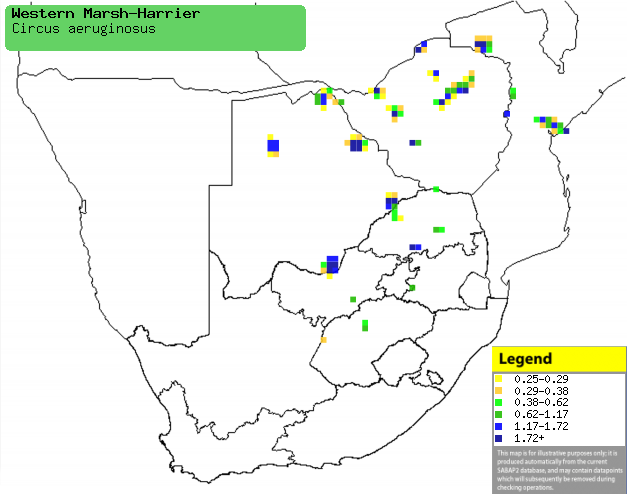|
Circus aeruginosus (Western
marsh-harrier, European marsh-harrier)
Europese paddavreter [Afrikaans]; Europese vleivalk
[Afrikaans]; Bruine kiekendief [Dutch]; Busard des roseaux [French];
Europšische rohrweihe [German]; Tartaranh„o-ruivo-dos-pauis [Portuguese]
Life
> Eukaryotes >
Opisthokonta
> Metazoa (animals) >
Bilateria >
Deuterostomia > Chordata >
Craniata > Vertebrata (vertebrates) > Gnathostomata (jawed
vertebrates) > Teleostomi (teleost fish) > Osteichthyes (bony fish) > Class:
Sarcopterygii (lobe-finned
fish) > Stegocephalia (terrestrial
vertebrates) > Tetrapoda
(four-legged vertebrates) > Reptiliomorpha > Amniota >
Reptilia (reptiles) >
Romeriida > Diapsida > Archosauromorpha > Archosauria >
Dinosauria
(dinosaurs) > Saurischia > Theropoda (bipedal predatory dinosaurs) >
Coelurosauria > Maniraptora > Aves
(birds) > Order: Falconiformes
> Family: Accipitridae
> Genus: Circus
Distribution and habitat
Breeds across much of Eurasia, heading south in the
non-breeding season to sub-Saharan Africa, largely avoiding from the DRC and
Angola. It is a rare visitor to southern Africa, with records of individuals
(especially immature females) spread across Botswana, Zimbabwe, central Mozambique and northern South
Africa. It generally prefers perennial freshwater wetlands, although it may move
into coastal and temporary inland wetlands, especially if they are dominated by reeds (Phragmites).
|
 |
|
Distribution of Western marsh harrier in southern Africa,
based on statistical smoothing of the records from first SA Bird Atlas
Project (©
Animal Demography unit, University of
Cape Town; smoothing by Birgit Erni and Francesca Little). Colours range
from dark blue (most common) through to yellow (least common).
See here for the latest distribution
from the SABAP2. |
Movements and migrations
Palearctic breeding migrant, arriving in
October and departing by April. It is most easily seen in the
north-east of southern Africa, in the period from late November to
late February.
Food
It mainly eats insects, supplemented with birds, mammals and
reptiles, doing most of its hunting aerially. It prefers to hunt on days with strong wind, holding its wings in a
V-shape with its head pointed down, so that it can spot prey. The following food items have been recorded
in its diet:
Threats
Not threatened, although its population seriously decreased
in the early 1990's, due to shooting, insecticide and lead-poisoning. Thankfully
it has since recovered well, and its population has increased.
References
-
Hockey PAR, Dean WRJ and Ryan PG 2005. Roberts
- Birds of southern Africa, VIIth ed. The Trustees of the John Voelcker
Bird Book Fund, Cape Town.
|
